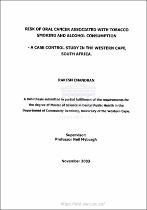| dc.description.abstract | Tobacco and alcohol consumption are well-established, high-ranking health risk behaviour in developed countries and the developing countries are catching up rapidly. There is very strong evidence in the literature to show that these behaviours feature prominently in the web of causation of many diseases either proximally or distally contributing substantially to global morbidity and mortality. Oral cancer is an important preventable cancer proven to be directly associated with tobacco and alcohol in many overseas studies. The study examines this
association in detail for the population of the Western Cape Province in South Africa in order to establish the existence, extent, dose and the duration of use relationship and the possibility of synergistic effect of these two often co-existing risk behaviours in the causation of oral cancer. A hospital based, analytical case control study using histologically confirmed cases originating from a single homogenous population group of the Western Cape was designed, Necessary data on 67 cases were collected from the Cancer Unit of Groote Schuur Hospital in Cape Town and that of 67 controls from other clinics in the same hospital using an interview schedule specifically prepared and tested in the same hospital. The cases and controls were individually matched for age, gender and ethnicity. The statistical analysis of the data shows that: (1) There is strong relationship between oral cancer and smoking (Odds Ratio 4.63, 1.74-t230 95% C.I) and alcohol use (Odds Ratio 7.21, 3.07-16.93 C.I); (2) The risk increases by six fold when the duration of use is more than 35 years in case of tobacco and eleven fold with more than 30 years of alcohol use; (3) The quantity of tobacco (> 10 cigarettes/day) and alcohol (> 500 grams/week) increases the risk of oral cancer by two fold and twenty four fold respectively; (4) Very few people in the study were able to quit the habit and thus the existence of risk reduction with cessation of the habit could not be proven statistically; (5) Statistically significant synergism exists among the people who indulge in smoking and alcohol use (Odds Ratio 9.61, 2.909-31.73 C.I). The findings of the study strongly support the efforts of the South African government to implement the tobacco legislation strictly and its campaign for responsible drinking. Concerted efforts though media campaign and education among the adolescents are strongly recommended. This study did not examine the effect of poor oral hygiene in the development of oral cancer and further research is suggested. | en_US |

